
The following is an excerpt from the work by Bob Avakian, The New Communism. In addition to this and other excerpts posted on revcom.us, we will be running further excerpts from time to time on revcom.us. These excerpts should serve as encouragement and inspiration for people to get into the work as a whole, which is available as a book from Insight Press and as a PDF online at revcom.us.


This excerpt comes from the section titled "III. The Strategic Approach to An Actual Revolution."
Here is a point that’s been made before: You have this kind of pyramid, with the ruling class at the top, and on one side of this are openly reactionary and fascistic forces, like all those clowns—and worse than clowns—competing even now for the Republican nomination. Jesus Christ! Donald Trump, 75% of the news these days is about Donald Trump. But there’s a reason for that. Not just one section of the ruling class, but the ruling class as a whole feels it’s important to have this atmosphere of anti-immigrant hysteria, and other reactionary fascistic kinds of programs, put forward as part of “legitimate political discourse.” And the more openly reactionary and fascist section of the ruling class, on one side at the top of this pyramid, is very aggressively pushing its program, while the other side is continually conciliating with that—and even when they fight back, they mainly fight back to conciliate and compromise more. Then you go down the two sides of the pyramid, and you get the different social bases in society: you get those forces in society that more spontaneously gravitate toward the ruling class programs and policies that are promoted as “liberal” or “progressive”; and, on the other side, you have those who more spontaneously gravitate toward openly reactionary fascistic-type programs and policies. Well, we have to repolarize this to a very great degree—and we not only have to win over large numbers of those who are presently “under the wing” of the section of the ruling class presenting itself as “liberal,” or “progressive” (as embodied, more or less, in the Democratic Party); we also have to win over, or politically neutralize, as much as possible, those who now look to the section of the ruling class that is more openly reactionary and fascistic (as represented by the core of the Republican Party). It is important to be clear on this: There are decisive and deep-going contradictions around which there are very real differences within the ruling class, in terms of how to deal with those contradictions—and the sharpening of those differences, to the point where it becomes increasingly difficult for the ruling class as a whole to maintain relative unity in its ranks and continue ruling in a way that maintains the “normal functioning” of its system, is one of the key elements in the development of a revolutionary situation—but the coming civil war is not going to take shape in terms of the “liberal section” of the ruling class waging some kind of all-out fight against the fascist section of the ruling class. That’s not how it’s gonna go—and that’s not the situation, and the polarization, that we want and need. The alignment in society has to be radically transformed—winning growing numbers of people, not just among the basic masses but more broadly as well, away from a position of subordination and “allegiance” to one or another section of the ruling class and to the system that this ruling class as a whole represents and enforces.
These things are—here comes that word again—complex. An actual revolution might involve a significant element of fighting against attempts to undermine or to eliminate certain aspects of bourgeois-democratic rights (things like the right to protest); and we, as scientific communists, have to know not only how to correctly wage but to lead that aspect of the fight, without allowing it to be, or to remain, on the terms of bourgeois democracy (just preserving the bourgeois system with the rights you’re supposed to have under this system). In the book Democracy: Can’t We Do Better Than That? the point is made that the contradiction between the professions of bourgeois democracy and the reality of what it means to live under what is in fact the dictatorship of the bourgeoisie—that contradiction is a constant source of two things: a constant source of struggle, of resistance and rebellion, against the way in which the ruling class and its state constantly trample on supposed rights under this system; and, at the same time, a constant source of regenerating illusions (“If we could just have our rights, if everybody could just be treated equally,” and so on and so forth). Well, we have to know how to handle that contradiction in a way that doesn’t reinforce bourgeois democracy—which is, in reality and in essence, bourgeois dictatorship—but instead leads toward the overthrow of the bourgeois (capitalist) system that this dictatorship maintains and enforces. Here enters in another important point from Lenin, which we have to grasp firmly: Lenin emphasized that a socialist revolution is not made in some kind of simpleminded way where one army lines up somewhere and says, “we’re for socialism,” and another army lines up and says, “we’re for imperialism.” Nothing that simpleminded will ever lead to a revolution. There is, and will be, all kinds of complexity in the field, including forces who are all over the map and going this way and that.
Now, speaking of maps, this relates to the point I’ve made before, using the metaphor of a multi-colored and multi-layered map—although I don’t know if people have understood that metaphor, and what it’s getting at, correctly. That metaphor is speaking to social contradictions and contradictory social phenomena and trends. What it’s getting at is that there are different ways that people in society can be identified and “categorized”—for example, population by gender, population by “race,” population by income and social status, identification of people according to whether they hold different beliefs, and so on—and these things both overlap and separate people out. For example, you have in the middle strata, or particularly in the educated middle strata, a growing move toward secularism. A lot of atheists are coming out of the closet these days. And this growing phenomenon of secularism among educated middle strata is definitely a positive development. But, they have a lot of shit that keeps them away from the revolution. You can think of what is represented by that skeptic Michael Shermer, to whom I referred to earlier—on the one hand, opposition to religious obscurantism and a fairly passionate advocacy of critical thinking and rational thought, but on the other hand a striking blindness regarding the actual reality of capitalism and its consequences, and what can only be described as a kind of shamefaced apology for the horrors that are embodied in the history of this country and the development of capitalism here, including the reality and role of slavery in all this. And, at the same time, among this section of the middle class in particular, there is at this point all the relativism, as well as anti-communism, with which we are all too familiar. This is very sharply dissected in the Interview with Ardea Skybreak, where she speaks about the contradictory attitudes that are common among these people: Well, we kinda want radical change, but, uhhhh, we kinda don’t. But there is this positive development toward secularism, as well as some other positive sentiments and inclinations among these strata.
Then you’ve got the people who are the real bedrock base for this revolution, and who most desperately need this revolution, but who are, more than ever right now, steeped and mired in a lot of religious obscurantism.
So, if you have a simpleminded approach, you’re never going to get anywhere. All you can do is add up the negative parts: We can’t get to the middle strata because they’re all caught up in this, “Eh, we kinda do, but, eh, we kinda don’t; oh, and my life’s not so bad, personally, if you don’t mind my saying so, and even if you do”; and, on the other hand, you have masses who are, yes, terribly oppressed, but they’re overwhelmingly caught up in religion right now, and this is a real chain on them. You could look at that and conclude that we’re never gonna get anywhere. But if you are being scientific—if you are applying dialectical materialism, in a living way—you recognize that these are contradictions we’re faced with, and the question is: How are we going to work on them, in which direction are we working on these contradictions? How do we carry out work and struggle so that, as Mao put it, we mobilize all positive factors? Not by making them up in our imaginations—or by trying to “add up” the positive elements in a linear and mechanical way, while ignoring the negative side of things—but by working on the actual contradictions with an approach that, yes, unites with and builds on the positive aspects, and at the same time transforms and repolarizes people, and in that way combines all positive factors. These are all the kinds of things you have to deal with if you actually want to get out from this horror show that masses of people are forced to live under, day after day, generation after generation.
Contents
Publisher's Note
Introduction and Orientation
Foolish Victims of Deceit, and Self-Deceit
Part I. Method and Approach, Communism as a Science
Materialism vs. Idealism
Dialectical Materialism
Through Which Mode of Production
The Basic Contradictions and Dynamics of Capitalism
The New Synthesis of Communism
The Basis for Revolution
Epistemology and Morality, Objective Truth and Relativist Nonsense
Self and a “Consumerist” Approach to Ideas
What Is Your Life Going to Be About?—Raising People’s SightsPart II. Socialism and the Advance to Communism:
A Radically Different Way the World Could Be, A Road to Real EmancipationThe “4 Alls”
Beyond the Narrow Horizon of Bourgeois Right
Socialism as an Economic System and a Political System—And a Transition to Communism
Internationalism
Abundance, Revolution, and the Advance to Communism—A Dialectical Materialist Understanding
The Importance of the “Parachute Point”—Even Now, and Even More With An Actual Revolution
The Constitution for the New Socialist Republic in North America—
Solid Core with a Lot of Elasticity on the Basis of the Solid Core
Emancipators of HumanityPart III. The Strategic Approach to An Actual Revolution
One Overall Strategic Approach
Hastening While Awaiting
Forces For Revolution
Separation of the Communist Movement from the Labor Movement, Driving Forces for Revolution
National Liberation and Proletarian Revolution
The Strategic Importance of the Struggle for the Emancipation of Women
The United Front under the Leadership of the Proletariat
Youth, Students and the Intelligentsia
Struggling Against Petit Bourgeois Modes of Thinking, While Maintaining the Correct Strategic Orientation
The “Two Maximizings”
The “5 Stops”
The Two Mainstays
Returning to "On the Possibility of Revolution"
Internationalism—Revolutionary Defeatism
Internationalism and an International Dimension
Internationalism—Bringing Forward Another Way
Popularizing the Strategy
Fundamental OrientationPart IV. The Leadership We Need
The Decisive Role of Leadership
A Leading Core of Intellectuals—and the Contradictions Bound Up with This
Another Kind of “Pyramid”
The Cultural Revolution Within the RCP
The Need for Communists to Be Communists
A Fundamentally Antagonistic Relation—and the Crucial Implications of That
Strengthening the Party—Qualitatively as well as Quantitatively
Forms of Revolutionary Organization, and the “Ohio”
Statesmen, and Strategic Commanders
Methods of Leadership, the Science and the “Art” of Leadership
Working Back from “On the Possibility”—
Another Application of “Solid Core with a Lot of Elasticity on the Basis of the Solid Core”Appendix 1:
The New Synthesis of Communism:
Fundamental Orientation, Method and Approach,
and Core Elements—An Outline
by Bob AvakianAppendix 2:
Framework and Guidelines for Study and DiscussionNotes
Selected List of Works Cited
About the Author